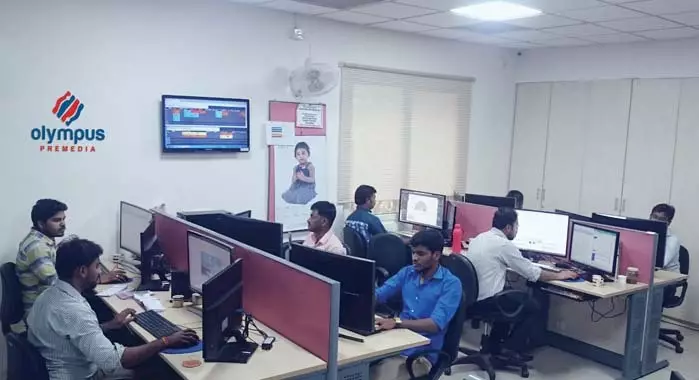On the one hand, we prepare packaging artworks for different print formats and on the other, we work with printers regarding colour specifications, explains Vijay Ayyappan, CEO, Olympus Premedia, to Dibyajyoti Sarma
Today, we are increasingly using the term pre-media instead of pre-press. This signals a major shift in approach. But what is the difference between traditional pre-press and modern pre-media?
Traditionally, the focus of pre-press, whether in-house or as a service bureau, has been firing plates for printing. There may be some amount of retouch on the original artwork, but the pre-press segment does not actively help in creating the final product.
On the other hand, pre-media is involved from the conception of a project.
According to Vijay Ayyappan, CEO, Olympus Premedia, there are a number of emerging technologies, especially for the packaging sector, which traditional pre-press shops did not focus on, as it called for diverse skills, and software. Also pre-press shops have defined customer base, mostly print service providers. On the other hand, a pre-media company’s client base includes diverse end-users.
“In the packaging graphics segment, some of the services that are not in the purview of pre-press include new digital services such as 2D/ 3D packshots, 3D rendering, CGI imagery, CGI animation, preparation of brand guidelines, creative retouch, and design,” Ayyappan adds.
Essentially, pre-media is closely tied to digital and connectivity where one single output can be used in different platforms for variety for purposes. Ayyappan explains, “We specialise in packaging graphics services where inputs such as pack copy, elements, dies and guidelines are supplied and we output colour-managed print-ready native as well as normalised pdf. The same inputs and final artworks are used to generate a wide variety of outputs, such as 2D, 3D packshots, 3D PDF, digital proofs, mockups, and also 3D printing. The static images can be used for promotions.”
Adapting to same processes
As pre-media is the first step towards product actualisation, it is important for a pre-media company to be on the same page with its clients. How does this process work?
Ayyappan argues that technology enables all stakeholders in the packaging supply chain adapt to the same process, workflow and operating procedures. “A packaging design can originate from a US-based designer for a Canadian brand. The same design is briefed and standardised by the brand management company, which in turn sends the files to a pre-media company for artwork execution,” he says, adding, “In addition to artwork execution, we also remotely proof the artwork using Epson printers at the agency site. The printer can also download the final files and setup jobs. All this is made possible through technology and tighter workflow.”
So, what is the pre-media company’s level of involvement in introducing the final product? What should be the ideal working relationship between a pre-media firm and a print firm?
In packaging especially, pre-media companies play a big role in getting out the final product, says Ayyappan. “We play a pivotal role in the supply chain. On the one hand, we prepare packaging artworks for printers for different print formats, such as litho, flexo, gravure and digital. This can be quite challenging. On the other hand, we also need to work with the printers regarding specifications, especially colour specifications. This is an important task,” he adds.
Working with digital
Today, technology is changing faster than we can keep a tab on. In this context, how can a pre-media company help its clients find the right technology partner?
“Pre-media houses can be faster in adopting new and emerging technologies than printers due to the structure and agility of the business,” Ayyappan says. “Today, process standardisation with the support of cloud-enabled robust applications for end-to-end tracking/ updation of various digital assets at low price points is a reality. Brands have a unique plus wide scope to use these platforms as this will enable them to roll out products faster and economically,” Ayyappan says.
And how does Olympus keep a tab on technologies? “We subscribe to a variety of industry magazines, blogs and participate in trade fairs to understand the changing environment. However, the important feedback on technology comes from our customers in the USA, the UK or Europe,” he adds.
So digital has opened up a wide world of possibilities. How can a pre-media firm take advantage of the opportunities?
Ayyappan says it will depend on the segments within pre-media services. “For publishing services, for example, page composition services will be more automatic with less manual interventions. All contents will be seamlessly prepared for different devices and formats,” he says.
For packaging pre-media, Ayyappan says, colour managed workflow, extended gamut, and digital presses will play significant roles. “Due to the possibilities of short runs and lower printing cost, brands will change SKUs more frequently,” he adds.
Explaining the activities of Olympus, Ayyappan says the company works with a variety of packaging printers in USA and Europe.
“They have all the print processes (digital, gravure, flexo, and litho) and work with thousands of brands. What is common is the inconsistency or different range of requirements from customer to customer. The complexity is based in brand guidelines, printer’s specs, regulatory requirements, print process, size of the label/ format, number of colours, etc,” he says.
According to Ayyappan, Olympus is one of the few pre-press houses in India with the wide range of applications such as Esko, Hybrid, GMG, Adobe and have built the competency to satisfy the most successful converters and the brand owners.
About Olympus Premedia
Chennai-based Olympus is an independent (non-captive) packaging pre-media service catering to packaging converters, trade shops, packaging graphics services providers and brand management companies.
Its range of services include:
Packaging artwork production
Brand rollout and extension
Pre-press and repro services (preparing print-ready files for different print formats in less than 18 hours)
Structural mock-ups (2D/3D) (from structural to digital mock-up options for virtual rendering)
Image works (high-end retouching or manipulating to make printready images)
Proofing and colour management (manage artwork colours according to press profile to achieve acceptable contract proof)












 See All
See All